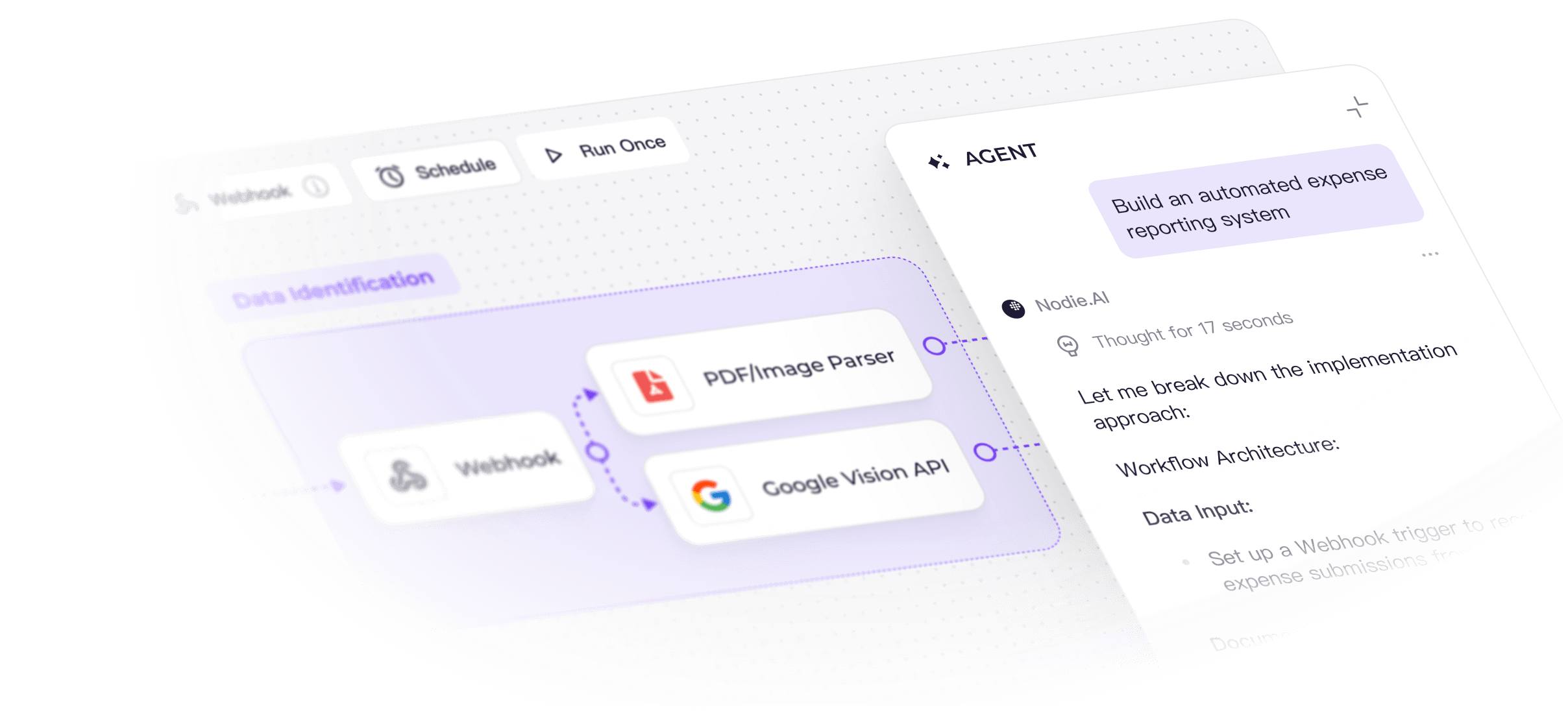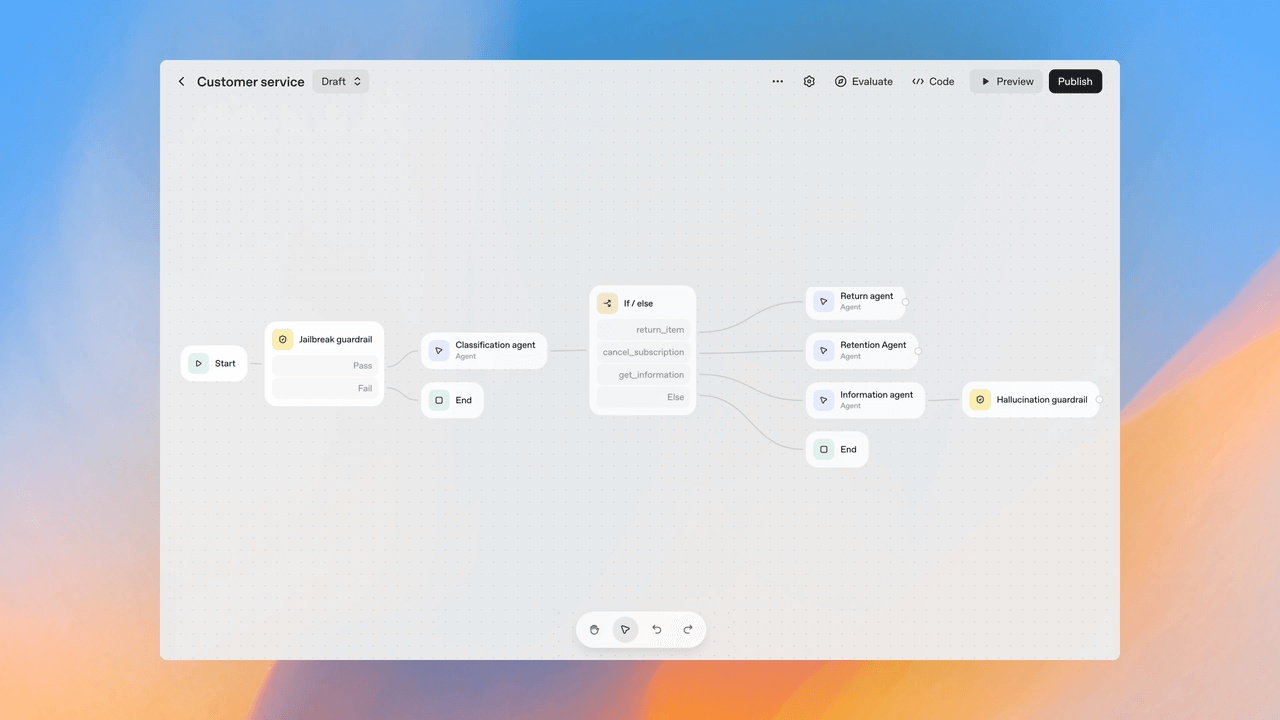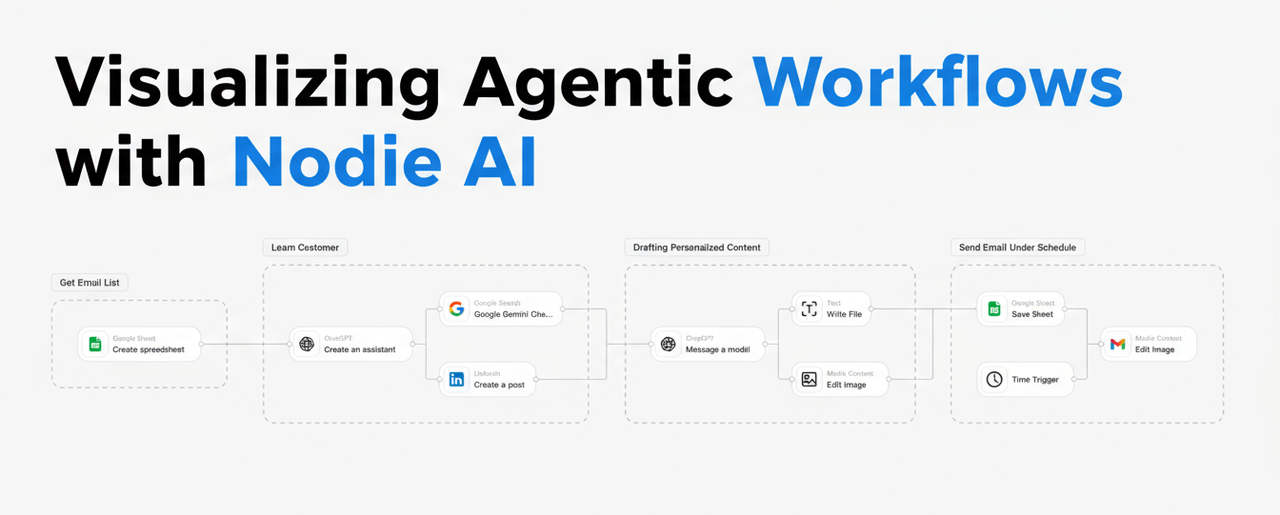
AgentKit and the Rise of Agentic Workflows: A New Era of AI Automation
What Is AgentKit?
On October 6, 2025, OpenAI launched AgentKit, a comprehensive toolkit designed to help developers build, deploy, and optimize AI agents. Before AgentKit existed, building agents meant dealing with fragmented tools, complex orchestration systems, custom connectors, and weeks of frontend development work.
At its core, AgentKit helps you create workflows—automated sequences of tasks that AI agents can execute independently. It includes Agent Builder for visual workflow design, ChatKit for embedding chat interfaces, and a Connector Registry for managing data sources.
Core Components of AgentKit
Agent Builder
Agent Builder is a visual canvas where you can design multi-agent workflows by dragging and dropping nodes. It handles versioning and lets you configure evaluations right inside the interface. You can see how different parts of your workflow connect and test them before going live.
ChatKit
ChatKit helps you embed customizable chat experiences into your product without building everything from scratch. Instead of spending weeks on UI development, you can integrate a working chat interface in hours.
Connector Registry
The Connector Registry is a centralized place where enterprise admins can manage data sources across ChatGPT and the API. It includes pre-built connections to services like Dropbox, Google Drive, and SharePoint.
Additional Features
AgentKit also added enhanced evaluation capabilities. You can now create datasets, grade entire workflow traces, optimize prompts automatically, and even test models from other providers. There's also Guardrails, an open-source safety layer that helps protect your agents from doing things you don't want them to do.

Why AgentKit Matters: The Rise of Agentic Workflows
AgentKit represents more than just another developer tool—it signals a shift toward intelligent automation systems usually called agentic workflows. These are AI-powered processes that can reason, adapt, and make decisions autonomously, going far beyond traditional if-then automation.
This shift matters because it democratizes sophisticated automation. What once required months of custom development can now be built in hours, opening the door to a new era where intelligent agents handle complex, multi-step processes without constant human oversight.
What Are Agentic Workflows?
Agentic workflows are intelligent, autonomous processes where AI agents handle multi-step tasks without you having to babysit them. Instead of simple if-this-then-that rules, these workflows can fetch data, transform it, make decisions, and deliver results all on their own.
How They Differ from Traditional Automation
Think of it this way. Traditional automation is like following a recipe exactly as written. Agentic workflows are more like having a chef who understands what you want to eat and figures out the best way to make it happen, adjusting along the way if something goes wrong.
What Agentic Workflows Can Do
These workflows can do several things at once:
- Pull data from different APIs
- Scrape websites for information
- Generate content using language models
- Push results to Slack, email, databases, or webhooks
- Chain together research, classification, summarization, and approval loops
The key difference is adaptability. Agentic workflows reason through context and adjust their steps in real time. If something fails, they can retry or find another path. If the data looks wrong, they can validate it before moving forward.
Five Key Advantages of Agentic Workflows
1. Time Efficiency
Tasks that used to require manual coordination across multiple tools now run automatically. You set them up once and they keep working.
2. Scalability
Whether you need to process ten items or ten thousand, the workflow handles it without needing more people.
3. Flexibility
When your business requirements change, you can modify the workflow instead of rebuilding everything from scratch.
4. Transparency
Modern agentic platforms show you each step of the process, making it easy to see what's happening, debug problems, and optimize performance.
5. Reliability
Built-in error handling, automatic retries, and validation checks mean you get consistent results even when things go wrong.
AgentKit vs Nodie AI: A Direct Comparison
Both AgentKit and Nodie AI help you build agentic workflows, but they take very different approaches. AgentKit is built for developers and enterprises with engineering teams. Nodie AI is built for everyone else.
| Feature | AgentKit | Nodie AI |
|---|---|---|
| Who it's for | Developers and enterprises | Non-technical users, creators, small teams |
| How you build | Visual canvas with nodes and connectors | Describe what you want in plain English |
| Time to first workflow | Hours to days | Minutes |
| Technical knowledge needed | Moderate to high | None |
| Customization depth | Very high | High enough for most needs |
| Available integrations | Limited to pre-built connectors (Dropbox, Google Drive, SharePoint) + custom development | 1,000+ actions across popular apps and services |
| Deployment | Requires integration work | Fully hosted, zero setup |
The Setup Experience
How AgentKit Works
With AgentKit, you start by opening Agent Builder and dragging nodes onto a canvas. You connect them together, configure each step, set up your data sources through the Connector Registry, and then test everything. If you want users to interact with your agent, you need to integrate ChatKit into your product. The process is much faster than building from scratch, but you still need to understand APIs, data flows, and how to structure agent logic.
How Nodie AI Works
With Nodie AI, you start by describing what you want in plain language. Something like "Every day, grab 100 AI startup leads from LinkedIn, put them into Google Sheets, and send me a Slack summary." Nodie asks clarifying questions if it needs more information, proposes an execution plan, and builds the workflow. If you change your mind halfway through, you can just tell it what to adjust. The system keeps context across multiple rounds of conversation, so you don't have to start over.

Transparency and Control
AgentKit's Approach
AgentKit gives you a visual canvas where you can see all the nodes and connections. You can version your workflows, run traces to see what happened, and grade the results. This works well if you're comfortable reading technical diagrams and understanding how data flows through systems.
Nodie AI's Approach
Nodie AI generates workflows that you can inspect and edit without touching code. Every step is visible, and you can modify any part of the workflow directly. There are real-time logs, version control, and one-click runs. The platform assumes you're not a developer, so everything is designed to be understandable without technical background.
Connectors and Integrations
AgentKit's Connector System
AgentKit offers a Connector Registry with pre-built integrations for services like Dropbox, Google Drive, SharePoint, and Microsoft Teams. You can also add third-party MCPs. If you need something that's not available, you'll need to build a custom connector.
Nodie AI's Connector System
Nodie AI supports over 1,000 actions across different apps and services. If a specific connector doesn't exist, the AI fills the gap by using content transformation logic and generic HTTP requests. This means you're less likely to hit a wall where you can't connect to something you need.
Deployment and Delivery
AgentKit Deployment
With AgentKit, you need to handle deployment yourself. ChatKit makes it easier to embed chat interfaces, but you still need to integrate it into your product, manage hosting, and handle all the infrastructure.
Nodie AI Deployment
Nodie AI is fully cloud-hosted and supports multiple AI models out of the box, including GPT-4, Claude 3.5 Sonnet, Gemini Pro, and multimodal models for image and document processing. You don't deploy anything or manage infrastructure. The platform handles automatic scaling, error recovery, rate limiting, and security. You just specify where you want results delivered, whether that's Google Sheets, email, Slack, a database, or a webhook. Nodie handles everything else, including automatic bug checks.
Why Nodie AI Works Better for Non-Technical Users
The biggest difference comes down to how you interact with the system. AgentKit assumes you understand software development concepts. Nodie AI assumes you don't, and that's okay.
Natural Language Setup
Instead of learning how to structure workflows or configure nodes, you just describe what you want. The system figures out the rest. If it's unclear about something, it asks. If you realize you want something different, you just say so. The conversation feels like talking to a colleague who's helping you solve a problem.
Context Memory Across Conversations
Nodie AI remembers what you've talked about, even across multiple conversations. If you start building a workflow, take a break, and come back later, it picks up where you left off. If you completely change direction, it adapts without making you start from scratch.
Automatic Optimization Behind the Scenes
Behind the scenes, Nodie AI figures out the most efficient way to execute your workflow. It handles retries when things fail, manages rate limits so you don't get blocked by APIs, and validates outputs to make sure everything looks right. You get the benefits of careful engineering without having to do engineering.
Mixed Approach to Traditional and AI Tools
Some workflow tools only connect to APIs. Others only use AI. Nodie AI combines both. It can fetch data from traditional APIs, transform it, generate new content using language models, classify information, summarize results, and deliver everything wherever you need it. All in one workflow.
Zero Infrastructure Management
You don't need to set up servers, manage databases, or worry about scaling. Everything runs in the clouds. You get logs, versioning, scheduling, and webhook triggers without configuring any of them.
When to Choose Each Platform
Choose AgentKit If You Need
- A dedicated engineer to build and maintain workflows
- Deep customization and control over model behavior
- Integration into complex enterprise systems
- Advanced evaluation capabilities like trace grading and reinforcement fine-tuning
- Maximum flexibility for unique technical requirements
Choose Nodie AI If You Need
- Fast deployment without technical knowledge
- Workflows that ship in minutes instead of days
- Transparent, editable workflows without writing code
- Simplicity and speed over deep customization
- A solution for non-technical users, solo creators, or small teams
The Bottom Line
OpenAI's AgentKit is a significant step forward for developers building sophisticated agents. The visual Agent Builder, ChatKit, and Connector Registry make agent development much less painful than it used to be.
But for non-technical users and teams that need to move fast, Nodie AI offers a more direct path. By turning natural language into production-ready workflows complete with logs, versioning, and automatic error handling, Nodie lets anyone build agentic workflows without learning to code.
The question isn't which platform is better overall. It's which one is better for you. If you have engineering resources and need maximum control, AgentKit makes sense. If you want to describe what you need and have it running in minutes, Nodie AI is the faster choice.
Join our Nodie AI beta program and follow us on X or join our community to stay updated on the latest developments.